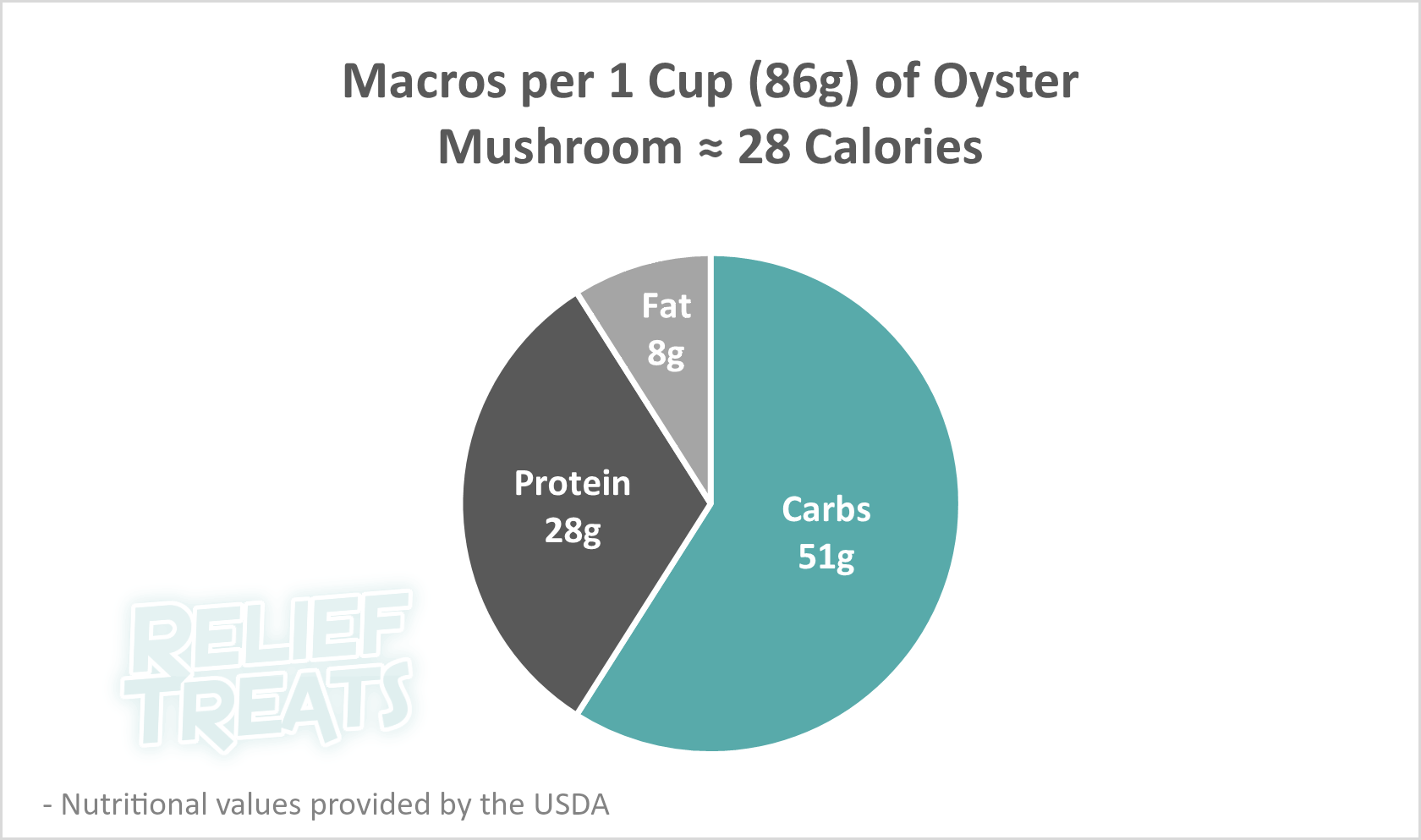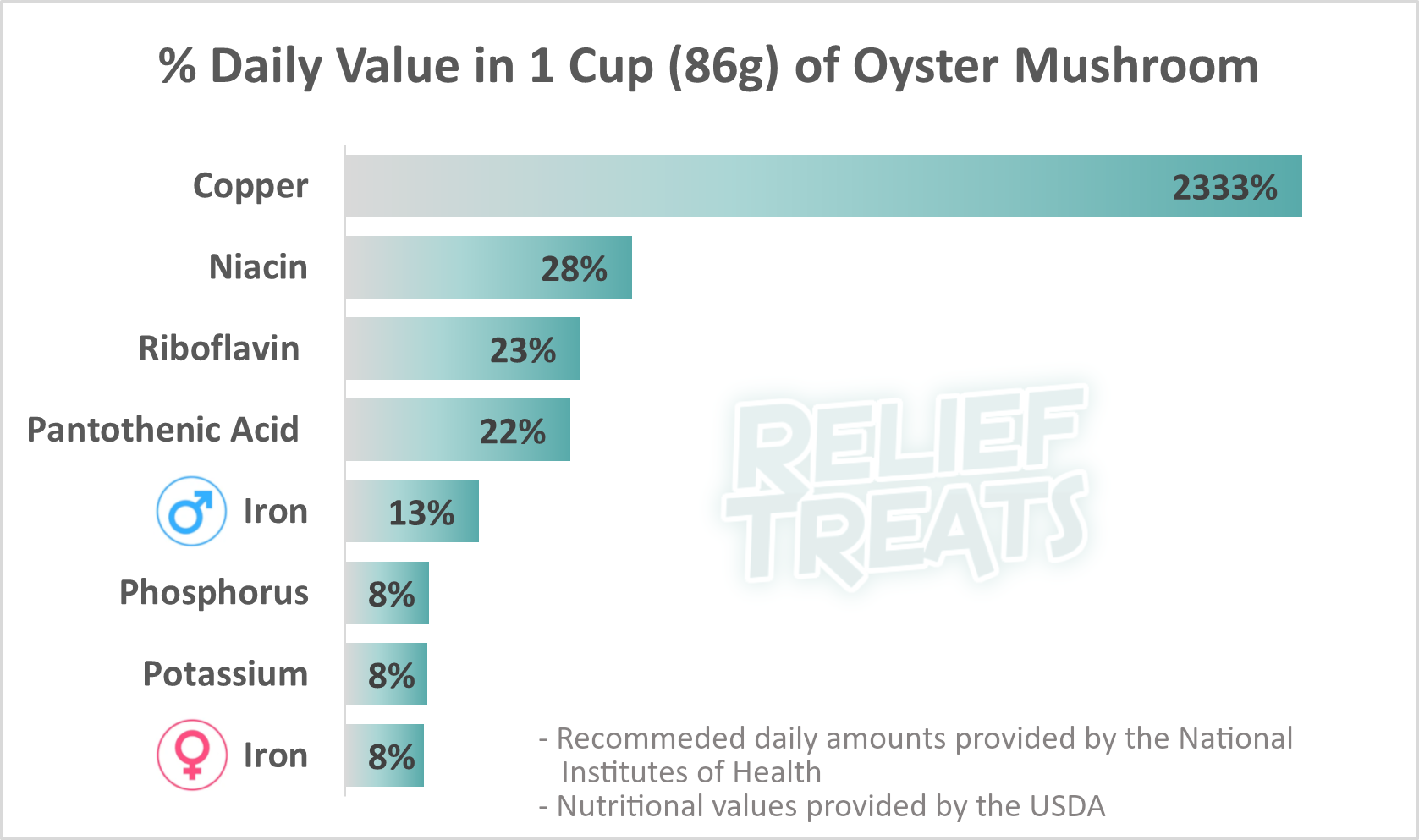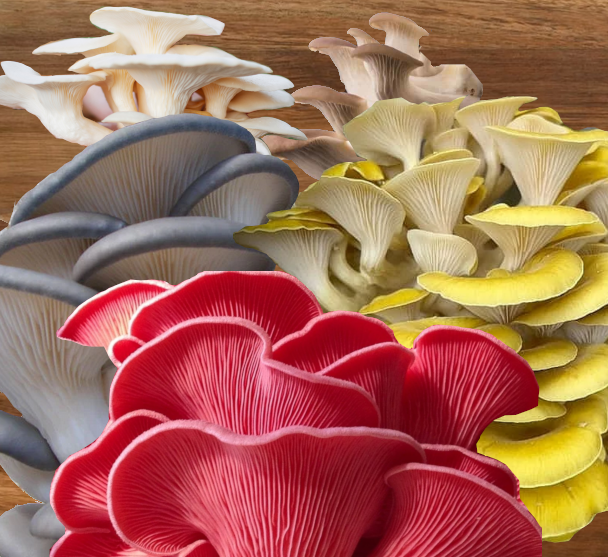Link in Bio, Wellness
Oyster Mushroom Nutritional Values and Benefits
About Oyster Mushrooms
Oyster mushrooms, or Pleurotus ostreatus (P. ostreatus), are some of the most commonly grown and eaten mushrooms in the world. They’re a species of gilled mushrooms classified under the Pleurotus genus and they boast nutritional, medicinal and even mycoremedial values meaning it can rid pollutants across the planet. They mainly grow on the sides of trees which is how they earned their earned their name which literally translates to side ear. There are over 40 varieties of oyster mushrooms and they’re all also commonly referred to as pleurotoids.
Oysters grow in both tropical and temperate environments leaving no mystery to how and why they’re so commonly found in nature. They’re also the 2nd most harvested mushroom in the world. They thrive on decaying wood but are also known to feast on nematodes by paralyzing them with an array of toxins that all pleurotoids possess, thus making them plant protectors as well.
There are dozens of P. ostreatus species such as pink oysters, golden oysters, phoenix oysters, king oysters, blue oysters and pearl oysters which are commonly found in the US. They’re relatively firm compared to other mushrooms and are generally safe to eat.
Consuming Oyster Mushrooms
Oysters are non-psychedelic and are commonly used as the main ingredient in vegan dishes but also pair well with seafood, pastas with creamy sauces and stir fries. Oyster mushrooms are mostly water but beyond their water content they’re rich in vitamin B and vitamin D and they also contain significant amounts of niacin, riboflavin, iron, pantothenic acid, potassium, phosphorus, copper and iron. Per the USDA, in every 1 cup (or ≈86 grams) of raw oyster mushrooms you will find approximately 28 calories, 3g of protein, 5g of carbs, 2g of fiber and less than half a gram of fat. They contain less than 1 gram of sugar (glucose) leaving the rest of their carb count to be mostly starch. Check out how oyster mushroom macros, micros and phytos measure up:[1]


↓ Full Nutritional Info Here ↓
| Water | 76.7g |
| Energy | 28.4kcal |
| Energy | 120kJ |
| Protein | 2.85g |
| Total lipid (fat) | 0.353g |
| Ash | 0.869g |
| Carbohydrate, by difference | 5.24g |
| Fiber, total dietary | 1.98g |
| Sugars, total including NLEA | 0.955g |
| Sucrose | 0g |
| Glucose | 0.955g |
| Fructose | 0g |
| Lactose | 0g |
| Maltose | 0g |
| Galactose | 0g |
| Starch | 0g |
| Calcium, Ca | 2.58mg |
| Iron, Fe | 1.14mg |
| Magnesium, Mg | 15.5mg |
| Phosphorus, P | 103mg |
| Potassium, K | 361mg |
| Sodium, Na | 15.5mg |
| Zinc, Zn | 0.662mg |
| Copper, Cu | 0.21mg |
| Manganese, Mn | 0.097mg |
| Selenium, Se | 2.24µg |
| Vitamin C, total ascorbic acid | 0mg |
| Thiamin | 0.107mg |
| Riboflavin | 0.3mg |
| Niacin | 4.27mg |
| Pantothenic acid | 1.11mg |
| Vitamin B-6 | 0.095mg |
| Folate, total | 32.7µg |
| Folic acid | 0µg |
| Folate, food | 32.7µg |
| Folate, DFE | 32.7µg |
| Choline, total | 41.9mg |
| Betaine | 10.4mg |
| Vitamin B-12 | 0µg |
| Vitamin A, RAE | 1.72µg |
| Retinol | 0µg |
| Carotene, beta | 24.9µg |
| Carotene, alpha | 0µg |
| Cryptoxanthin, beta | 0µg |
| Vitamin A, IU | 41.3IU |
| Lycopene | 0µg |
| Lutein + zeaxanthin | 0µg |
| Vitamin E (alpha-tocopherol) | 0mg |
| Tocopherol, beta | 0mg |
| Tocopherol, gamma | 0mg |
| Tocopherol, delta | 0mg |
| Tocotrienol, alpha | 0.026mg |
| Tocotrienol, beta | 0mg |
| Tocotrienol, gamma | 0mg |
| Tocotrienol, delta | 0mg |
| Vitamin D (D2 + D3), International Units | 24.9IU |
| Vitamin D (D2 + D3) | 0.602µg |
| Vitamin D2 (ergocalciferol) | 0.602µg |
| Vitamin D3 (cholecalciferol) | 0µg |
| Vitamin K (phylloquinone) | 0µg |
| Vitamin K (Dihydrophylloquinone) | 0µg |
| Vitamin K (Menaquinone-4) | 0µg |
| Fatty acids, total saturated | 0.053g |
| SFA 4:0 | 0g |
| SFA 6:0 | 0g |
| SFA 8:0 | 0g |
| SFA 10:0 | 0g |
| SFA 12:0 | 0g |
| SFA 14:0 | 0g |
| SFA 15:0 | 0g |
| SFA 16:0 | 0.053g |
| SFA 17:0 | 0g |
| SFA 18:0 | 0g |
| SFA 20:0 | 0g |
| SFA 22:0 | 0g |
| SFA 24:0 | 0g |
| Fatty acids, total monounsaturated | 0.027g |
| MUFA 14:1 | 0g |
| MUFA 15:1 | 0g |
| MUFA 16:1 | 0g |
| MUFA 17:1 | 0g |
| MUFA 18:1 | 0.027g |
| MUFA 20:1 | 0g |
| MUFA 22:1 | 0g |
| MUFA 24:1 c | 0g |
| Fatty acids, total polyunsaturated | 0.106g |
| PUFA 18:2 | 0.106g |
| PUFA 18:3 | 0g |
| PUFA 18:4 | 0g |
| PUFA 20:2 n-6 c,c | 0g |
| PUFA 20:3 | 0g |
| PUFA 20:4 | 0g |
| PUFA 20:5 n-3 (EPA) | 0g |
| PUFA 21:5 | 0g |
| PUFA 22:4 | 0g |
| PUFA 22:5 n-3 (DPA) | 0g |
| PUFA 22:6 n-3 (DHA) | 0g |
| Fatty acids, total trans | 0g |
| Cholesterol | 0mg |
| Stigmasterol | 0mg |
| Campesterol | 0.86mg |
| Beta-sitosterol | 0mg |
| Tryptophan | 0.036g |
| Threonine | 0.12g |
| Isoleucine | 0.096g |
| Leucine | 0.144g |
| Lysine | 0.108g |
| Methionine | 0.036g |
| Cystine | 0.024g |
| Phenylalanine | 0.096g |
| Tyrosine | 0.072g |
| Valine | 0.169g |
| Arginine | 0.157g |
| Histidine | 0.06g |
| Alanine | 0.206g |
| Aspartic acid | 0.254g |
| Glutamic acid | 0.544g |
| Glycine | 0.108g |
| Proline | 0.036g |
| Serine | 0.108g |
| Alcohol, ethyl | 0g |
| Caffeine | 0mg |
| Theobromine | 0mg |
People who eat oyster mushrooms commonly describe their flavor as seafood-like. They’re typically dense and full with a velvety texture that crisps nicely around the edges when fried just right. They can often be found in your local grocery store since they can be harvested year-round and are relatively easy mushrooms to grow if you have trouble finding them. When selecting them be sure to look for full, in-tact and firm bodies/clusters that do not have any wilting, bruising or excess moisture. When fresh, oyster mushrooms can be stored for about a week in the fridge but not much longer. It’s recommended that you don’t seal them airtight as moisture can cause mold during storage. Keeping them in a paper bag or on a plate covered by a paper towel is just fine. They can also be dehydrated or frozen and stored for much longer.
Preparing mushrooms can be a delicate process since they bruise and deform easily. Ideally you can just brush/wipe any debris off of them with a brush or paper towel. Rinsing them with water is also an option but it’s important you get them completely dry before storing or cooking them as excess moisture can impact texture and quality. There’s surely an oyster recipe for everyone but for those who just can’t get past taste or texture there are many other ways to consume oyster mushrooms and still reap their health and wellness benefits. Powders and capsules are widely available online and it gets even more creative with teas, coffee powders, hot cocoa powders and special blends of mushrooms that work synergistically with each other. Most mushrooms are pet-friendly too so don’t be surprised if you see options for your companion as well.
Health Benefits
One of the most thorough reviews on health benefits of oyster mushrooms is actually a mega study compiling many other studies into one combined review. Researchers gathered numerous oyster mushroom studies filtering down to only those that were conducted in English and on humans resulting in 102 unique records. They then removed 94 of those studies from their sample for reasons ranging from other mushrooms in addition to oysters being administered during the study all the way to test subjects having unrelated but pre-existing conditions. Left with 8 studies combined, it was concluded that oyster mushrooms show potential to benefit many biometrics such as glucose, lipid metabolism and profile, blood pressure and overall cardiometabolic health. HOWEVER they also concluded the only 8 remaining studies that met their stringent criteria still had flaws such as methodological shortcomings and insufficient reporting which drove them to this final conclusion:
“current findings on the efficacy of P. ostreatus intake on cardiometabolic parameters can only be considered as suggestions of a beneficial effect. Thus, further clinical trials with a well-controlled study design are necessary.”[3]
Researchers sure can be picky but luckily we still have other reputable individual publications to consider. Here’s what some had to say:
Heart Health
P. ostreatus has shown to contain high amounts of dietary fibers called beta-glucans which are crucial in the production of short-chain fatty acids that can help reduce cholesterol production. A small 2011 randomized control trial including 20 people found that eating a soup containing 30 grams of dried P. ostreatus for 21 days decreased triglycerides, oxidized LDL (bad) cholesterol levels and total cholesterol compared to the placebo group.[16]
It’s no surprise that foods high in fiber such as vegetables and mushrooms are also low in calories and conducive to overall wellbeing. A 2019 study concluded, “The abundance of dietary fiber in whole grain, protein food, fruits, and vegetables, makes them attractive targets for disease prevention and reduction of risk of atherosclerosis and cardiovascular disease.”[7]
A different study in 2021 that focused on mushrooms in general concluded, “Edible mushroom consumption may have favorable effects on lipid profiles by changing some metabolic markers such as low-density lipoprotein (LDL) cholesterol, high-density lipoprotein (HDL) cholesterol, total cholesterol, and triglycerides. Moreover, edible mushroom consumption is probably associated with reduced mean blood pressure.”[8]
Two other oyster mushroom studies to consider regarding heart health use rats and mice as test subjects. One conclusion from the rat study was, “Feeding of P. sajor-caju, P. ostreatus and P. florida reduced body weight significantly in hypercholesterolemic rats.”[4] And the conclusion of the mouse study was that dietary fiber from oyster mushrooms, ”may be useful in reducing hepatic triglyceride accumulation.”[9]
Immunity
A 2016 study cited oyster mushrooms’ already proven ability to support immunity in rodents and wanted to prove the same ability in humans. 41 test subjects (4 men and 37 women) consumed either an oyster mushroom extract or placebo for 8 weeks and then had various bio markers evaluated. In their conclusion they go into detail about something called Th1 phenotype and how it potentiates as the macrophage-IL-12 – IFN-γ pathway confirming that also in humans, ”Oyster mushroom extract may be beneficial for the prevention of various diseases by stimulation of the immune system.”[10]
Systemic inflammation has been linked to the pathogenesis of a variety of diseases. A 2011 study administered oyster mushroom concentrate on mice and concluded “the results of our study show that the edible oyster mushroom possesses anti-inflammatory activity. As such, the mushroom and its extract or concentrate, such as OMC, can be considered a functional food that has the potential to control inflammation.”[11]
Oyster mushrooms contain a powerful antioxidant amino acid called Ergothioneine (ERGO) which is known for its ability to reduce oxidative stress and mitigate chronic neurodegenerative diseases. A 2016 study demonstrated that ERGO blood levels in human subjects decline with age and declined faster in those who show cognitive impairment compared to age-matched individuals with no cognitive impairment.[14] Just 1 year prior, a similar study showed that blood ERGO levels were lower in individuals with Parkinson’s Disease (PD) than with age-matched individuals without the disease.[15] The ERGO content of commercially grown edible mushrooms such as white button (Agaricus bisporus) and gray oyster (Pleurotus ostreatus) mushrooms are much higher (630 and 1310 mg/kg d.w., respectively) than foods, such as oats, kidney beans or chicken livers, which contain some of the next highest documented levels (1.8, 2.1 and 47 mg/kg d.w., respectively).[15]
There’s also supported sentiment that consuming oyster mushrooms may have chemo-protective properties for certain cancers however this sentiment comes mostly from test tube and animal studies. Due to lack of human research no reputable health publications note mushrooms as being able to cure any cancers at this time.
Metabolism
Mushrooms being a high fiber, low calorie option naturally will be conducive to weight loss. Of course, other factors like activity level, genetics and other foods consumed can have an equal or greater impact so balance would be best advised if weight loss is the goal.
A very interesting 2005 study administered oyster mushrooms to diabetic humans in alternating 7-day intervals; meaning the subjects consumed oyster mushrooms for 7 days, then they did not consume any for 7 days, then went back to consuming for 7 days, then stopped again for 7 days and so on for 7 consecutive months… They were tested every 7 days and consuming oyster mushrooms consistently lowered both fasted glucose and 2 hrs post-meal glucose. Also, both glucose levels increased when test subjects abstained from consuming oyster mushrooms for 7 days. The same study also found consistent decreases in total cholesterol and triglycerides during the on weeks and increases in both in the off weeks.[12]
Adverse Possibilities
When consumed, oyster mushrooms are generally well tolerated however just like any other food there is a possibility of sensitivity or overconsumption. Symptoms of a reaction can include but not be limited to nausea, upset stomach, diarrhea and/or gas.
Proper care and prep are essential with mushrooms just the same as any other food because Salmonella, L. monocytogenes (Listeria) and Staphylococcus have all been linked to mushrooms – E. Coli has not.[13]
There’s also some evidence that some mushrooms may somehow affect how the drug gabapentin, commonly used for epilepsy or pain relief, interacts with the body. However, that report specifically mentions shiitake mushrooms and not oysters. The final conclusion was that the potential interaction “may not have clinically important consequences.”[6]
When handled, oyster mushrooms are again generally well tolerated however there is at least one report of a worker having a bad reaction from handling them. In the report the subject complains of chills, fever, joint pain and skin rashes. The report also mentions medical history may have played a role but ultimately he was diagnosed with hypersensitivity pneumonitis. He was free of symptoms in a few days and discharged within a week.[5] The report concluded, “Indoor cultivation, leads to allergic symptoms such as extrinsic allergic alveolitis known as hypersensitivity pneumonitis (HP) in workers. HP that caused by repeated inhalation of organic antigens and inorganic low-molecular-weight particles is a non-IgE-mediated hypersensitivity reaction in susceptible people. Although there are different reasons HP’s clinical, radiological and pathological features are shared.”[5]
Before consuming/handling oyster mushrooms consider that research on them is limited and personal variables can impact each individual’s experience. Pregnancy, medical history, genetic predisposition and so much more can significantly alter how someone may respond when introducing anything new to their diet. Be sure to consult your physician before making any changes you’re unsure of.
Also, nature can be very convincing with something called mimicry – you see it all the time with plants, animals and even fungi. Mimicry is when one species appears to be like another unrelated species through coloration, behavior or other physical traits – it’s a survival adaptation. Some harmful mushrooms look like harmless ones and vice versa. Always be sure you know what you’re eating when it comes to mushrooms because they are very potent in most things they contain.
Final Thoughts
To sum it all up, oyster mushrooms can be a great addition to most diets and recipes and their benefits seem to far outweigh any potential adverse possibilities. There are many varieties across the globe so there’s almost always a way to put a new spin on an old classic. You might have luck finding it in your local supermarket and they can also be bought online. They can even be foraged for free and reproduced endlessly in your home creating a healthy, low cost and sustainable food source. The options are limitless with just this one species so don’t hesitate to try as many as possible.
Sources
- Nutritional values – https://fdc.nal.usda.gov/fdc-app.html#/food-details/168580/nutrients
- Recommended daily amounts (RDA) – https://ods.od.nih.gov/HealthInformation/healthprofessional.aspx
- Dicks L, Ellinger S. Effect of the Intake of Oyster Mushrooms (Pleurotus ostreatus) on Cardiometabolic Parameters—A Systematic Review of Clinical Trials. 2020; 12(4), 1134. doi: 10.3390/nu12041134
- Alam N, Amin R, et al. Comparative Effects of Oyster Mushrooms on Lipid Profile, Liver and Kidney Function in Hypercholesterolemic Rats. Mycobiology. 2009; 37(1): 37–42. doi: 10.4489/MYCO.2009.37.1.037
- Bekci TT, Calik M, Calik SG, Esme H. Oyster mushrooms (pleurotus ostreatus) caused hypersensitivity pneumonitis: Mushroom worker’s lung. European Respiratory Journal. 2014;44(58)4023
- Toh DS, Limenta LM, Yee JY, et al. Effect of mushroom diet on pharmacokinetics of gabapentin in healthy Chinese subjects. British Journal of Clinical Pharmacology. 2014;78(1):129-34. doi: 10.1111/bcp.12273
- Soliman GA. Dietary fiber, atherosclerosis, and cardiovascular disease. Nutrients. 2019;11(5):1155. doi: 10.3390/nu11051155
- Kritanawong C, Isath A, et al. Mushroom Consumption and Cardiovascular Health: A Systematic Review. Am J Med. 134(5):637-642.e2. doi: 10.1016/j.amjmed.2020.10.035. Epub 2020 Dec 9
- Caz V, Gil-Ramírez A, Largo C, et al. Modulation of cholesterol-related gene expression by dietary fiber fractions from edible mushrooms. J Agric Food Chem. 2015;63(33):7371-7380. doi: 10.1021/acs.jafc.5b0294
- Tanka A, Nishimura M, et al. Enhancement of the Th1-phenotype immune system by the intake of Oyster mushroom (Tamogitake) extract in a double-blind, placebo-controlled study. https://www.ncbi.nlm.nih.gov/pmc/articles/PMC5067930/. J Tradit Complement Med. 2016; 6(4): 424–430. doi: 10.1016/j.jtcme.2015.11.004
- Jedinak, A., Dudhgaonkar, S., Wu, Ql. et al. Anti-inflammatory activity of edible oyster mushroom is mediated through the inhibition of NF-κB and AP-1 signaling. Nutrition Journal. 10, 52 (2011). https://doi.org/10.1186/1475-2891-10-52
- K Khatun, H Mahtab, et al. Oyster mushroom reduced blood glucose and cholesterol in diabetic subjects. Mymensingh Med J. 2007; 16(1):94-9. doi: 10.3329/mmj.v16i1.261
- M Samadpour, MW Barbour, et al. Incidence of enterohemorrhagic Escherichia coli, Escherichia coli O157, Salmonella, and Listeria monocytogenes in retail fresh ground beef, sprouts, and mushrooms. J Food Prot. 2006; 69(2):441-3. doi: 10.4315/0362-028x-69.2.441
- Cheah I, Feng L, et al. Ergothioneine levels in an elderly population decrease with age and incidence of cognitive decline; a risk factor for neurodegeneration? Biochem Biophys Res Commun. 2016; 478(1):162-167. doi: 10.1016/j.bbrc.2016.07.074. Epub 2016 Jul 19
- Beelman R, Kalaras M, et al. Is ergothioneine a ‘longevity vitamin’ limited in the American diet? J Nutr Sci. 2020; 9: e52. doi: 10.1017/jns.2020.44
- Schneider I, Kressell G, et al. Lipid lowering effects of oyster mushroom (Pleurotus ostreatus) in humans. Journal of Functional Foods Volume 3, Issue 1. 2011; 17-24. https://doi.org/10.1016/j.jff.2010.11.004

